Healthcare Gamification Market Research, 2031
The global healthcare gamification market size was $3.3 billion in 2021, and is projected to reach $9 billion by 2031, growing at a CAGR of 11% from 2022 to 2031. Gamification in the healthcare industry is gaining momentum. Digital practitioners or consultants use various gaming principles and techniques to improve patient clinical outcomes. Healthcare gamification techniques are widely used for patient behavior management, motivation & education, appointment booking, and prescription tracking. These games are patient-centric and designed to improve patient engagement by making their experiences more personalized. The patient participates in gaming activities and earns rewards. Besides, in some healthcare gamification apps, patients can set challenges for themselves and evaluate their health progress, while, in some apps, the patient completes with other patients. By participating in different activities and challenges, patients feel motivated and engaged. The companies developing mobile healthcare games are incorporating games into digital monitoring apps. The main purpose of incorporating the game into digital monitoring apps is to increase patient engagement and create health data that can be used for personalized treatment. These apps not only improve patient clinical outcomes but also help medical practitioners too.
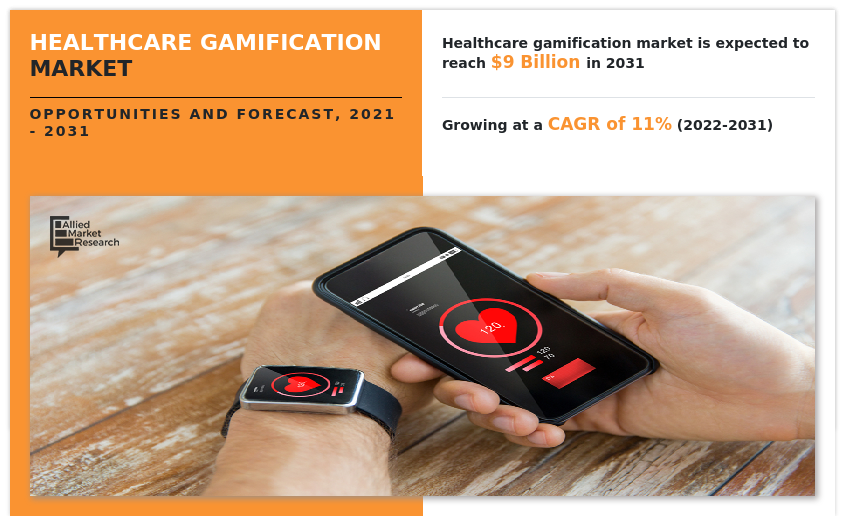
The growing penetration of smartphones is the main factor driving the demand for the global healthcare gamification market during the forecast period. As per bankmycell.com, globally, there are around 6.3 billion smartphone users in 2021, and the number is expected to reach 7.33 billion by 2025. The increasing internet penetration and smartphone users in rural parts of the world have also contributed to the market growth. Furthermore, the growing number of smartphone users has encouraged mobile health app developers to incorporate games into digital health monitoring apps to increase patient clinical outcomes. These digital apps and healthcare games provide information about prevention, diagnosis, treatment, and disease management, which help the user manage their health. These applications, with the help of various sensors in a smart watch or smartphone, help users check and monitor their health conditions. For instance, the dietary intake monitoring app enables dialysis patients to monitor food intake by providing real-time feedback, thereby assisting patients and medical professionals in the personalized treatment plan. The growing use of smartphones and internet penetration is anticipated to fuel the demand for the healthcare gamification market.
User acceptance is the key factor for the growth of the global healthcare gamification market analysis. However, the low acceptance rate and lack of knowledge about the apps among patients are the major factors hindering the global healthcare gamification market growth during the forecast period. Moreover, it is difficult to understand patient psychology using smartphones and digital apps. In addition, there has been a dearth of knowledge of healthcare gamification in emerging nations. As a result, the rate of adaptation is low. Such factors are expected to hinder market growth during the forecast period.
The app developers are working towards incorporating games for patients in the digital health monitoring tools. The growing penetration of digital health apps will provide the global healthcare gamification market opportunities for growth. For instance, as per the report and survey by Rock Health, in 2018, around 90% of American adults used digital health monitoring apps such as apps or wearable devices to monitor their health. Around 11% of people track their medication with digital tools and apps, while 20% of obese people track their weight with the app. Hence, the increasing use of digital apps and wearable devices is projected to provide growth opportunities for the market in the coming years.
The global healthcare gamification market analysis is segmented based on game type, application, end-use, and region. By game type, the market is sub-segmented into Exercise Games, Serious Games, and Casual Games. By application, the market is classified into Education, Therapeutic, Prevention, and Others. By end-use, the market is classified into Consumer Based and Enterprise Based. By region, the market is analyzed across North America, Europe, Asia-Pacific, and LAMEA.
The key players profiled in the global healthcare gamification industry are Mango Health, Nike, Fitbit, Bunchball, Ayogo Health, Microsoft, Hubbub Health, EveryMove, Akili Interactive labs, and JawBone, among others.
The healthcare gamification market is segmented into Game Type, Application and End User.
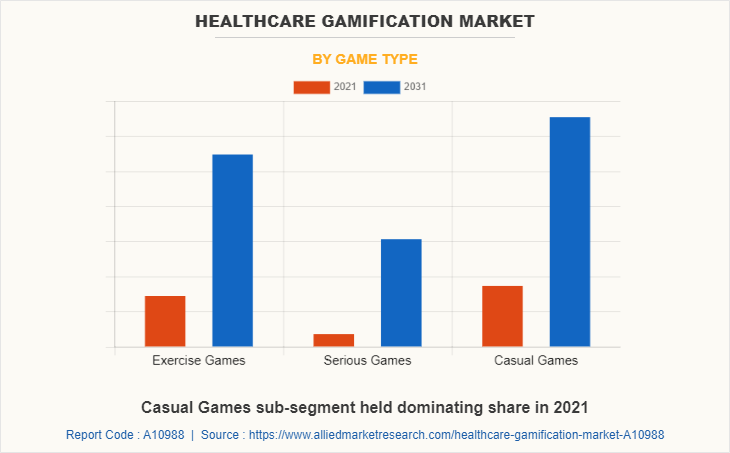
Casual games held the largest market share in 2021. Casual games are easy, short, and enjoyable games. These games are popular among young patients. Besides, mere entertainment, casual games teach patients about particularities of disease and act as a bridge for transferring information between medical practitioners and parents. This is primarily due to the use of casual games in healthcare platforms to treat patients by monitoring their behavior. The growing popularity of casual games among young patients is the major factor driving the demand for casual games during the forecast period.
The serious game is predicted to be the fastest growing sub-segment during the forecast period. Serious games are gaining momentum in the global healthcare gamification market forecast. These games are developed using 3D computer technologies and are more often associated with education and entertainment. Serious games are educational tools and are used for educating patients and medical practitioners. Serious games are capable of making a change in the behavior of the patient. Increasing penetration and development of serious healthcare games is the main factor driving the demand for serious games during the forecast period.
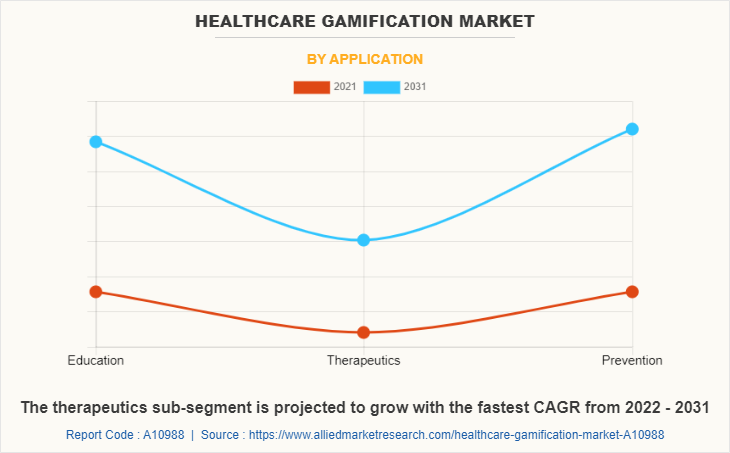
Preventions application is projected to be dominating the market. Games in the healthcare sector are gaining prominence due to numerous benefits. These games help patients in disease prevention and disease management. Using gaming techniques, the patient can avoid unnecessary hospital visits and can manage disease remotely. As these games are developed using 3D computer technology, the patient can virtually combat mental health and disease, as well as, prevent future disease through simulation techniques.
The therapeutic application sub-segment is anticipated to be the fastest growing during the forecast period. Video games are widely used in healthcare settings to distract the patient from pain and psychological trauma. Video games have helped patients who are dealing with disorders like depression, anxiety, post-traumatic stress disorder (PTSD), and attention deficit hyperactivity disorder (ADHD). These games not only improve health but also result in more patient satisfaction by providing them with the right gaming tools for therapy. The increasing use of healthcare games by medical practitioners to engage patients during various therapies is projected to drive the market during the forecast period.
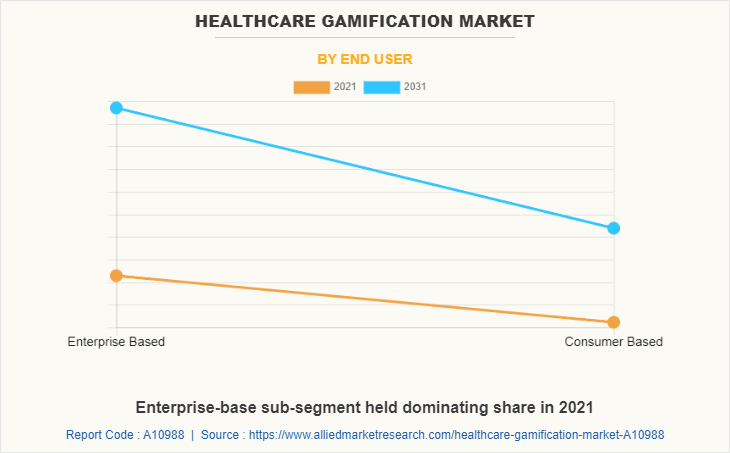
Enterprise-based sub-segment held dominating share in 2021. Numerous firms throughout the world are known to place a strong emphasis on improving the physical health and wellness of their workforces. The majority of firms are known to support wellness programs for their staff. Such an increase in employer initiatives toward the health of the employee is expected to drive the enterprise-based segment in the near future.
Consumer-based sub-segment is expected to be the fastest growing during the forecast period. It is a personalized healthcare model that is concentrated on individuals ‘health experiences’ and is, thus, a ‘cross-disease’ model. Such a model consists of telemedicine, online therapy, Diabetes App that Provides Personal Tracking and Recommendations to the patient, etc. The growing use of wearable devices and smartphones is the key factor driving the demand for the healthcare gamification market during the forecast period.
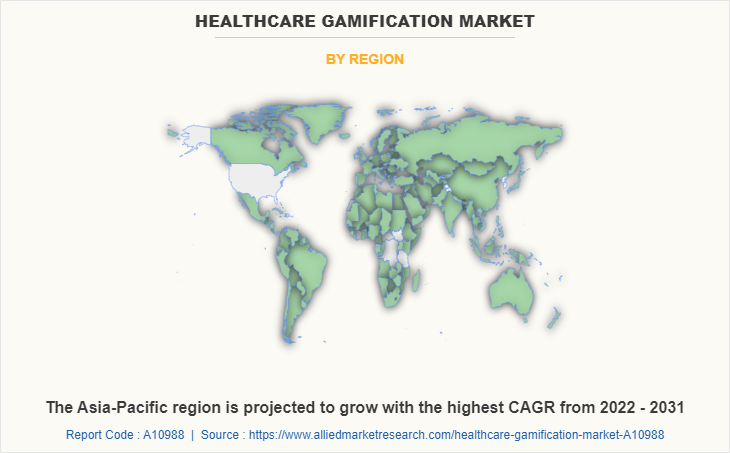
The Asia-Pacific has the largest market share and is predicted to be dominating the market during the forecast period due to the increasing smartphone adoption and digital healthcare apps. Furthermore, improving healthcare infrastructure and the growing use of wearable devices for tracking health will further boost the market during the forecast period.
The Europe region is expected to be the fastest growing region across the globe during the forecast period. The growth of the market is attributed to factors such as the growing acceptance of gamified models throughout the healthcare system, the rising prevalence of chronic diseases, and use of wearable devices. Such factors are expected to propel the growth of the region.
Key Benefits For Stakeholders
- The report provides exclusive and comprehensive analysis of the global healthcare gamification market trends along with the healthcare gamification market forecast.
- The report elucidates the healthcare gamification market opportunity along with key drivers, and restraints of the market. It is a compilation of detailed information, inputs from industry participants and industry experts across the value chain, and quantitative and qualitative assessment by industry analysts.
- Porter’s five forces analysis helps analyze the potential of the buyers & suppliers and the competitive scenario of the market for strategy building.
- The report entailing the healthcare gamification market analysis maps the qualitative sway of various industry factors on market segments as well as geographies.
- The data in this report aims on market dynamics, trends, and developments affecting the healthcare gamification market growth
Impact of COVID-19 on the Global Healthcare Gamification Market.
- During the COVID-19 pandemic, the demand for healthcare gamification increased due to the increased adoption of digital health apps.
- Therapy centers, fitness institutes, and community centers were not functional during the COVID-19 pandemic. These compel people to use digital healthcare apps and tools to track their health.
- Digital health care and fitness apps were available alternatives for most people to track their daily activities and fitness regime. These propel the demand for the healthcare gamification market during the COVID-19 pandemic.
- In-person meetings with Medical practitioners, therapists, and consultants was limited, as a result, several digital healthcare tool developer incorporated prescription and medication tracking in the digital health monitoring apps.
Healthcare Gamification Market Report Highlights
| Aspects | Details |
| Market Size By 2031 | USD 9 billion |
| Growth Rate | CAGR of 11% |
| Forecast period | 2021 - 2031 |
| Report Pages | 200 |
| By Game Type |
|
| By Application |
|
| By End User |
|
| By Region |
|
| Key Market Players | Ayogo Health Inc, hubbub health, inc, Nike, Inc., CogniFit, Fitbit, Inc, Microsoft, Akili Interactive Labs, Inc, Bunchball inc, EveryMove, Mango Health |
| Other Players | Medtronic |
Analyst Review
The application of gamification in the healthcare sector is scaling due to several benefits. Digital medical practitioners are using games to improve patient clinical outcomes. Medical practitioners often use games to improve the mental health of people suffering from anxiety, depression, and trauma pain. Using games, the patient can set challenges for themselves, as well as compete with other patients. These games help the digital consultant to track the daily activities of the patient, thereby helping them with personalized medication.
The increasing penetration of the internet in the rural part of the world and the growing adoption of smartphones are the key factors propelling the growth of the global healthcare gamification market during the forecast period. In addition, the incorporation of prescription and medication tracking functions by mobile digital healthcare tracking apps will further propel the demand for the global healthcare gamification market in the coming years.
Among the regions, Asia-pacific is anticipated to have the highest revenue in the market by the end of 2031, followed by Europe, North America, and LAMEA. Improving healthcare infrastructure, adoption of digital healthcare technology, and advancement in IT are the key factors responsible for the leading position of Asia-Pacific and Europe in the global healthcare gamification market.
The growing adoption of wearable health tracking devices and increasing penetration of smartphones are the main factors driving the global healthcare gamification market. Changing lifestyles have led to an increase in the incidence of severe chronic diseases and mental disorders, even at a young age. In addition, the aging population is estimated to generate excellent opportunities in the healthcare gamification market.
The major growth strategies adopted by healthcare gemification market players are investment and collaboration.
Asia-Pacific is estimated to be the largest regional market in 2021
The key players profiled in the Healthcare Gamification market report include Nike, Ayogo Health, Fitbit, Bunchball, Microsoft, EveryMove, Hubbub Health, Akili Interactive labs, Mango Health, and JawBone, among others.
The global Healthcare Gamification market was valued at $3,260.0 million in 2021, and is anticipated to reach $9,040.9 million by 2031
Health conscious people, physiotherapy clinics and hospitals are the major customers in the global healthcare gemification market
The report provides an extensive qualitative and quantitative analysis of the current trends and future estimations of the global healthcare gemification market from 2021 to 2031 to determine the prevailing opportunities.
Loading Table Of Content...
Loading Research Methodology...



